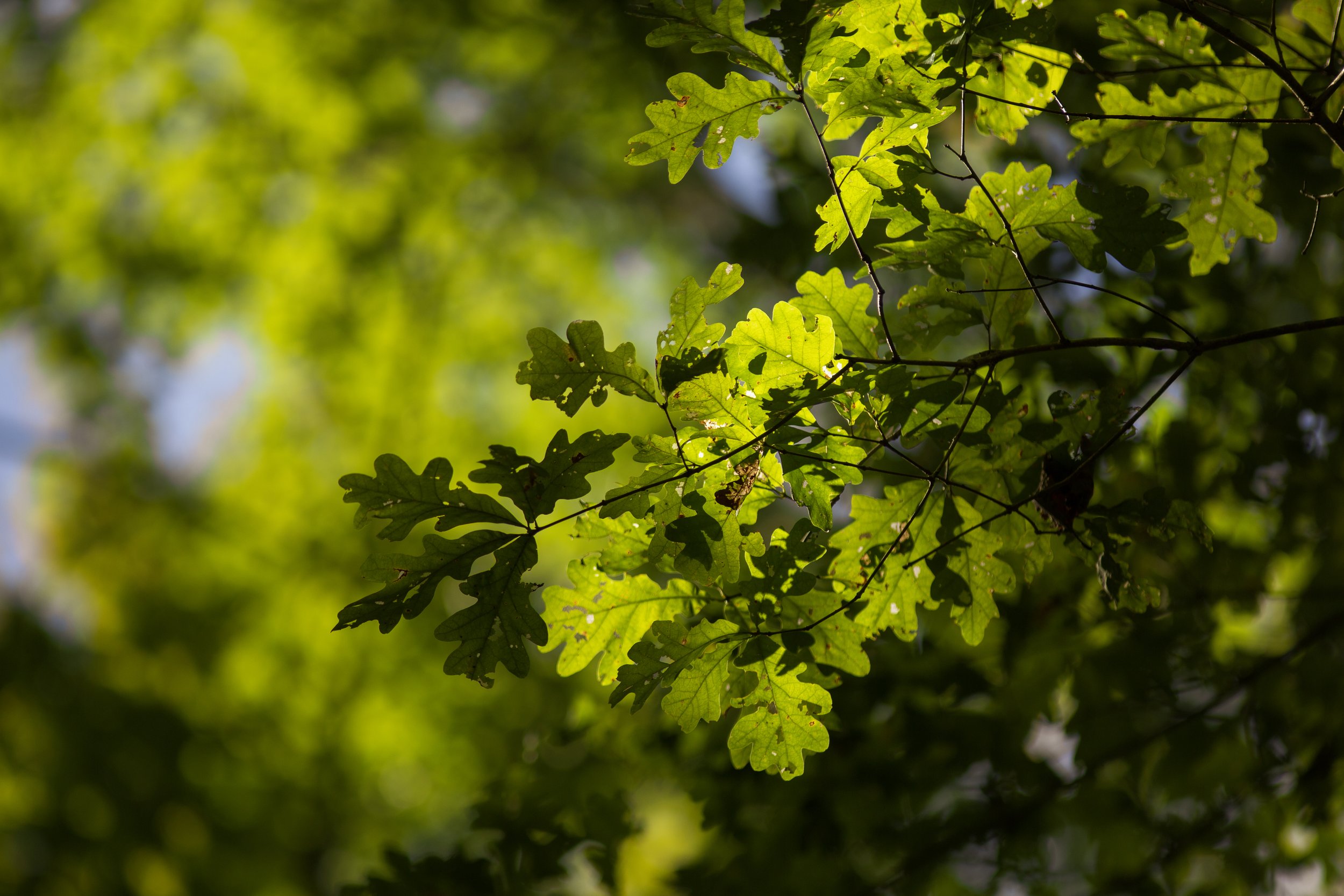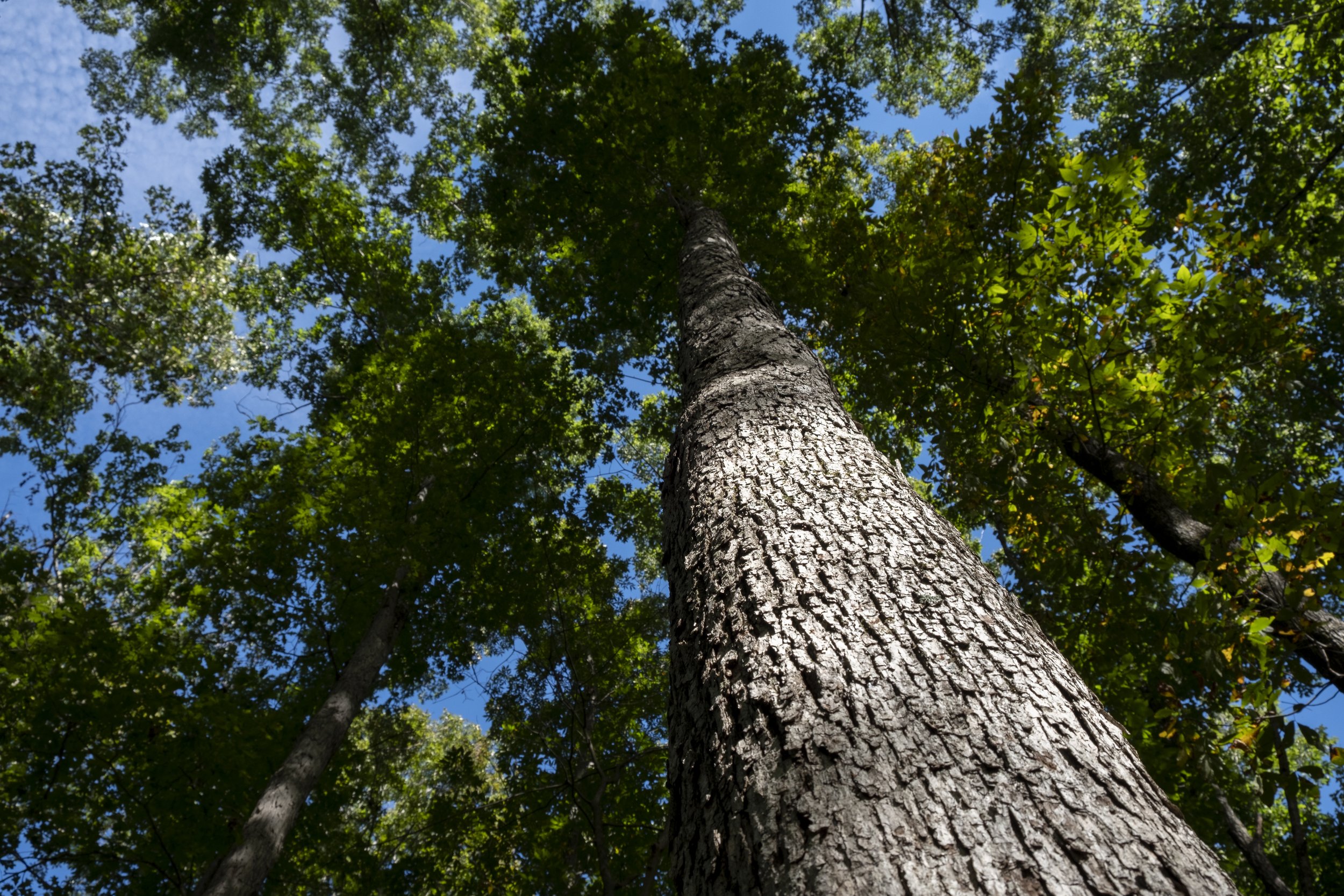
White Oak Facts
American white oaks are a foundational tree species. They hold a unique and vital place within forests due to their many ecological, economic and social contributions. Currently occupying more than 104 million acres of public and private forestland across much of the eastern and central United States, American white oak is mainly found in Alabama, Arkansas, Georgia, Illinois, Indiana, Iowa, Kentucky, Maryland, Michigan, Minnesota, Missouri, Pennsylvania, North Carolina, Ohio, Tennessee, Virginia, West Virginia and Wisconsin.
-
A: WOI doesn’t distribute these things directly, but we may connect you with organizations in our network that do. Please review our Landowner Resources.
-
A: The best case for oak regeneration is for your acorns to remain where windfall, jays, or squirrels distribute them and let them germinate. Young oak trees depend upon direct sunlight and protection from impacts like browsing deer, competition from other trees, and development. This requires proactive forest management, including prescribed fire and/or timber harvest. For this reason, we advocate working with local foresters and organizations who can help create a land management plan that supports your goals and values.
We’d also like to acknowledge the on-the-ground efforts of WOI partners who work in acorn collection programs, which are vital to local ecosystems. For example, in Tennessee, civic organizations, forestry groups, landowners, and citizens all contribute to securing Tennessee’s forests by gathering acorns—helping to preserve the ecological and economic benefits of white oak for future generations. We may be able to connect you with organizations in your area. Please review our Landowner Resources.
-
Oaks need direct sunlight. They don’t thrive in the shade, so they depend upon disturbances to the canopy of other shade tolerant trees. For thousands of years across what is now the eastern US, oak-dominated woodlands – including white oak – were maintained through methods like prescribed fire and selective harvesting, which opened the canopy and supported regeneration.. That’s forest management. In the past 200 years, however, land use and forest management changes have reduced such disturbances. As a result, invasive species have spread, wildlife habitats have declined, and lower-quality trees are dominating.
This shift has led to a process known as mesophication, where forests become cooler, damper, and more shaded, favoring shade-tolerant species like beech and maple over oaks. This makes it increasingly challenging for white oak and similar species to regenerate naturally.
-
A: White oak is not threatened with extinction nor is it listed as a species of special concern. Throughout its historic range we still have a significant amount of white oak present. However, in many places young oak trees are not thriving because of competition from other trees like beech and maple that can grow in the understory of our oak forests. The shade they create prevents small oak seedlings from growing into larger sapling size trees that are required to ensure that oak forests regenerate. So there are fewer oaks ready to replace the mature trees that fall to pests, disease, storm damage, harvest, or old age. This is called the “oak bottleneck.” We have time for forest management to make a difference. Practices can be used now that can increase the understory light and allow the small seedlings to grow in size, thus eliminating the oak bottleneck. Because we’re working with trees that can live for over 300 years, we need to apply best practices for white oak management now in order to avoid the oak bottleneck later.
-
A: White Oak is a charismatic icon. White oak supports more forms of life and ecosystem services than any other tree in North America. Forest management strategies that focus on oaks in general may not benefit white oak regeneration, but management strategies that focus on white oak regeneration do benefit upland oak ecosystems as a whole.
-
A: As advocates and catalysts of sustainable forest management that benefits white oak, our national role is to align the many stakeholders and efforts under a common national strategy for white oak conservation. We focus on policy and research, network development, and educational outreach to strengthen resources around white oak regeneration across its region. Our partners implement on-the-ground landowner support, conservation, research activities, plantings, and acorn collections while WOI provides national coordination to unify and amplify these efforts in support of our shared mission.
-
A: Partner with the WOI!
Thank you for your interest in supporting the White Oak Initiative. Every partnership plays a vital role in ensuring the long-term sustainability of upland oak ecosystems. Whether you’re an individual, business, or organization, there are many ways to collaborate with WOI—and we’re eager to hear your ideas!
Below are examples of how others have partnered with us, but we encourage you to get involved in ways that align with your goals and capacity. Let’s work together to make the greatest impact!
Ways to Partner with WOI:
Supporting Partners:Engage with WOI by amplifying our message and contributing to our mission in easy but impactful ways.
Follow and share WOI content on social media.
Subscribe to our newsletter.
Make one-time or recurring donations to support white oak conservation.
Amplifying Partners:Leverage your brand, platform, or resources to share WOI’s mission and raise awareness in your network.
Feature the WOI logo on a product or campaign.
Donate a portion of sales to WOI.
Collaborate on educational materials highlighting the importance of white oak sustainability.
Funding Partners:Provide critical financial support (five figures or more) to advance major projects, events, or national initiatives.
Sponsor a special-edition product that supports WOI.
Match employee contributions to WOI.
Fund a significant initiative or event that drives conservation efforts.
Community Partners:Foster local engagement by hosting events, facilitating discussions, or sharing knowledge in your community.
Organize a site visit to demonstrate effective oak management practices.
Host a roundtable or community event to promote white oak awareness.
Collaborate on regional conservation initiatives.
Implementing Partners:Take on-the-ground action to directly advance WOI’s goals through practical projects.
Lead tree-planting efforts or forest restoration days.
Conduct demonstration projects showcasing sustainable forest management.
Partner with local organizations to engage communities in conservation.
A Collaborative Approach
These categories are flexible and not hierarchical—many partners contribute in multiple ways. Whatever your focus, your involvement is valued and makes a difference.
If you have a unique approach or project in mind, we’d love to hear about it! Let’s start a conversation to explore shared objectives and create a partnership that works best for you.
Schedule a time to talk by clicking Meet.
-
A: WOI is committed to supporting forest landowners by connecting you with relevant resources and contacts. Please review our Landowner Resources, which include guides, funding sources, and state-specific directories. Depending upon your goals, we can often recommend connections within our network, such as regional forestry associations, cooperative extensions, or conservation groups. We’re happy to direct you to relevant partners who may be more directly involved with landowners like you.
-
A: Yes, thank you! Photos or media that capture the story of white oaks are always welcome. With your permission, we can use them with credit to you across our website, reports, and outreach materials. If you’re open to sharing, we’ll prepare a draft licensing agreement for review. Please contact us at info@whiteoakinitiative.org
-
A: We’re always interested in hearing directly from landowners like you. WOI doesn’t conduct land management but values practical insights that can inform our resources and support network. If you’d be interested in sharing your experiences, please contact us at info@whiteoakinitiative.org
-
A: Your passion for preserving trees and forests in your community is vitally important. The White Oak Initiative is dedicated to the long-term sustainability of upland oak ecosystems and white oak regeneration, focusing on rangewide and national-level efforts. At this time, we are unable to adequately advocate for individual trees, specific stands, or localized issues.
We encourage you to connect with conservation organizations, land management agencies, or forestry groups that may be better equipped to provide direct assistance or guidance for your situation. Your commitment to conservation makes a meaningful difference in protecting these vital ecosystems.
-
The wood produced from white oaks has unique characteristics — it is heavy, strong and water-resistant. This gives it outstanding commercial value among tree species, currently making it the most commercially important timber oak in the United States. In fact, white oak contributes billions of dollars yearly to various industries, including furniture production, flooring manufacturing, cabinetry production, and the wine and spirits sector.
-
The structure of white oak-dominated forests promotes vibrant and diverse ecosystems. The open midstories and dense ground cover these forests provide help create an environment that supports an extensive range of both plant and animal species. Upland oak trees, including white oaks, produce nutritious acorns that serve as an essential food source for wildlife. White oak acorns, in particular, are highly sought after by numerous creatures, such as white-tailed deer and wild turkey.
-
A: Sustainable white oak management requires the removal of small and low-value trees that compete with white oak for light, water, and nutrients. These removals support regeneration and long-term forest health, but without viable markets for these trees, landowners face financial barriers to implementing necessary management practices.
Historically, pulp and paper mills and biomass energy facilities provided markets for these materials, but many have closed across the white oak range. Expanding markets for wood residuals—such as biochar, sustainable aviation fuels, and wood-based composite materials—ensures landowners have economic incentives to actively manage their forests. Without these markets, white oak regeneration efforts become more difficult, threatening its long-term sustainability.
75% of White Oaks Are Mature
Older white oak trees are not being replaced by younger white oak trees at a pace that will support long-term sustainability. White oak trees can grow taller than 100 feet and have an impressive lifespan, often living for more than 300 years. Their longevity allows them to support forest ecosystems and contribute to forest stability over extended periods.
The White Oak Challenge
Research shows that while the existing white oak stocks are sufficient for near-future demand, there are strong indications of long-term sustainability problems due to a lack of regeneration.
About 75% of all white oak trees across the eastern United States can be classified as “mature,” while populations of young white oak trees are limited. In other words, older white oak trees are not being replaced by younger white oak trees at a pace that will support long-term sustainability.
This lack of regeneration is due to a variety of factors including shifts in land management, ecological changes and climate change, all of which can cause crowding, invasive species issues and other problems.
If this pattern continues unchecked, we risk experiencing a significant decline in the many ecological and economic benefits provided by white oak trees over the coming decades.
Hope for the Future
While there are plenty of mature white oaks in our forests today, the regeneration issue must be addressed immediately as oaks take decades to grow to maturity. We have a limited window to be proactive, but it can be done. By working together, we can reverse the decline of American white oak and ensure a sustainable future for white oak-dominated forests for generations to come.
Partner with Us
The White Oak Initiative welcomes questions and engagement from dedicated individuals and organizations.


